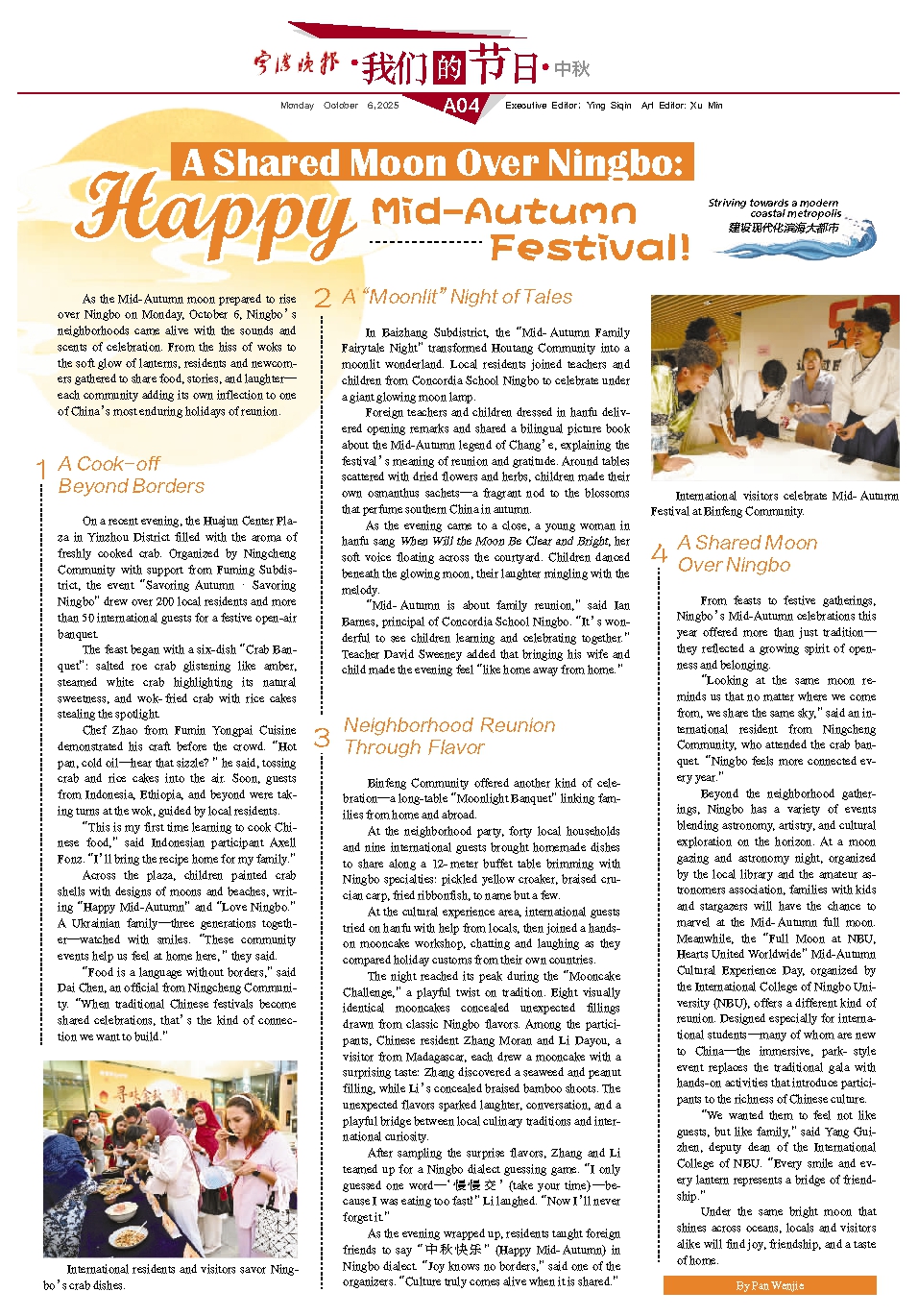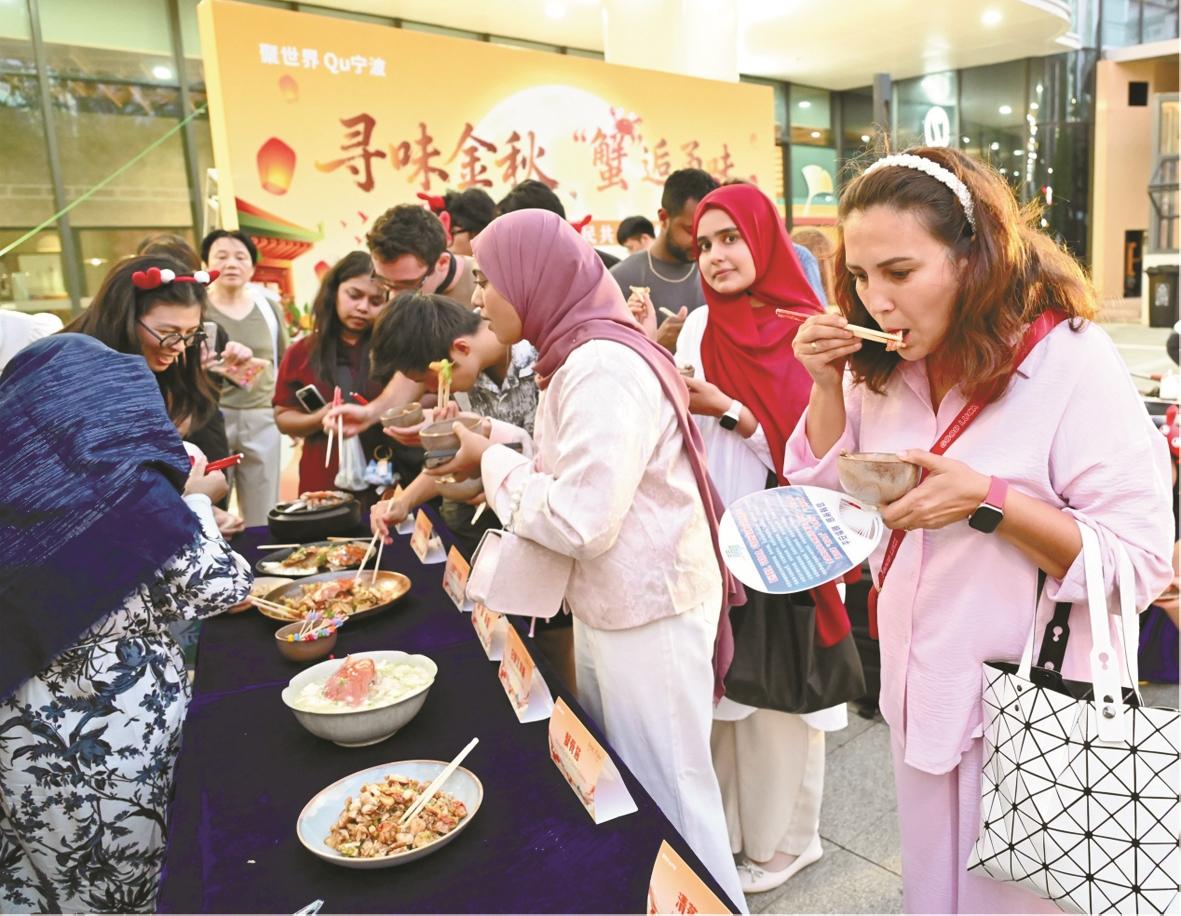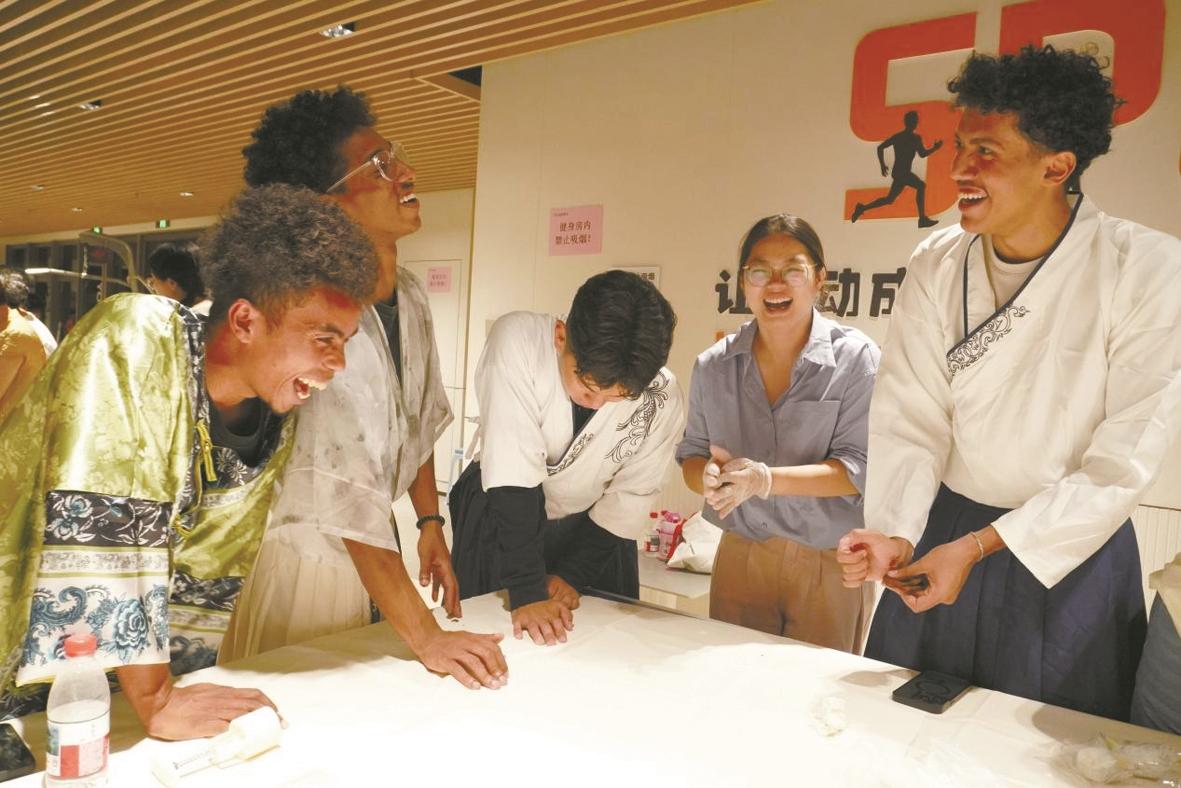As the Mid-Autumn moon prepared to rise over Ningbo on Monday, October 6, Ningbo’s neighborhoods came alive with the sounds and scents of celebration. From the hiss of woks to the soft glow of lanterns, residents and newcomers gathered to share food, stories, and laughter—each community adding its own inflection to one of China’s most enduring holidays of reunion.
1
A Cook-off
Beyond Borders
On a recent evening, the Huajun Center Plaza in Yinzhou District filled with the aroma of freshly cooked crab. Organized by Ningcheng Community with support from Fuming Subdistrict, the event “Savoring Autumn · Savoring Ningbo” drew over 200 local residents and more than 50 international guests for a festive open-air banquet.
The feast began with a six-dish “Crab Banquet”: salted roe crab glistening like amber, steamed white crab highlighting its natural sweetness, and wok-fried crab with rice cakes stealing the spotlight.
Chef Zhao from Fumin Yongpai Cuisine demonstrated his craft before the crowd. “Hot pan, cold oil—hear that sizzle? ” he said, tossing crab and rice cakes into the air. Soon, guests from Indonesia, Ethiopia, and beyond were taking turns at the wok, guided by local residents.
“This is my first time learning to cook Chinese food,” said Indonesian participant Axell Fonz. “I’ll bring the recipe home for my family.”
Across the plaza, children painted crab shells with designs of moons and beaches, writing “Happy Mid-Autumn” and “Love Ningbo.” A Ukrainian family—three generations together—watched with smiles. “These community events help us feel at home here,” they said.
“Food is a language without borders,” said Dai Chen, an official from Ningcheng Community. “When traditional Chinese festivals become shared celebrations, that’s the kind of connection we want to build.”
2
A “Moonlit” Night of Tales
In Baizhang Subdistrict, the “Mid-Autumn Family Fairytale Night” transformed Houtang Community into a moonlit wonderland. Local residents joined teachers and children from Concordia School Ningbo to celebrate under a giant glowing moon lamp.
Foreign teachers and children dressed in hanfu delivered opening remarks and shared a bilingual picture book about the Mid-Autumn legend of Chang’e, explaining the festival’s meaning of reunion and gratitude. Around tables scattered with dried flowers and herbs, children made their own osmanthus sachets—a fragrant nod to the blossoms that perfume southern China in autumn.
As the evening came to a close, a young woman in hanfu sang When Will the Moon Be Clear and Bright, her soft voice floating across the courtyard. Children danced beneath the glowing moon, their laughter mingling with the melody.
“Mid-Autumn is about family reunion,” said Ian Barnes, principal of Concordia School Ningbo. “It’s wonderful to see children learning and celebrating together.” Teacher David Sweeney added that bringing his wife and child made the evening feel “like home away from home.”
3
Neighborhood Reunion
Through Flavor
Binfeng Community offered another kind of celebration—a long-table “Moonlight Banquet” linking families from home and abroad.
At the neighborhood party, forty local households and nine international guests brought homemade dishes to share along a 12-meter buffet table brimming with Ningbo specialties: pickled yellow croaker, braised crucian carp, fried ribbonfish, to name but a few.
At the cultural experience area, international guests tried on hanfu with help from locals, then joined a hands-on mooncake workshop, chatting and laughing as they compared holiday customs from their own countries.
The night reached its peak during the “Mooncake Challenge,” a playful twist on tradition. Eight visually identical mooncakes concealed unexpected fillings drawn from classic Ningbo flavors. Among the participants, Chinese resident Zhang Moran and Li Dayou, a visitor from Madagascar, each drew a mooncake with a surprising taste: Zhang discovered a seaweed and peanut filling, while Li’s concealed braised bamboo shoots. The unexpected flavors sparked laughter, conversation, and a playful bridge between local culinary traditions and international curiosity.
After sampling the surprise flavors, Zhang and Li teamed up for a Ningbo dialect guessing game. “I only guessed one word—‘慢慢交’ (take your time)—because I was eating too fast!” Li laughed. “Now I’ll never forget it.”
As the evening wrapped up, residents taught foreign friends to say “中秋快乐” (Happy Mid-Autumn) in Ningbo dialect. “Joy knows no borders,” said one of the organizers. “Culture truly comes alive when it is shared.”
4
A Shared Moon
Over Ningbo
From feasts to festive gatherings, Ningbo’s Mid-Autumn celebrations this year offered more than just tradition—they reflected a growing spirit of openness and belonging.
“Looking at the same moon reminds us that no matter where we come from, we share the same sky,” said an international resident from Ningcheng Community, who attended the crab banquet. “Ningbo feels more connected every year.”
Beyond the neighborhood gatherings, Ningbo has a variety of events blending astronomy, artistry, and cultural exploration on the horizon. At a moon gazing and astronomy night, organized by the local library and the amateur astronomers association, families with kids and stargazers will have the chance to marvel at the Mid-Autumn full moon. Meanwhile, the “Full Moon at NBU, Hearts United Worldwide” Mid-Autumn Cultural Experience Day, organized by the International College of Ningbo University (NBU), offers a different kind of reunion. Designed especially for international students—many of whom are new to China—the immersive, park-style event replaces the traditional gala with hands-on activities that introduce participants to the richness of Chinese culture.
“We wanted them to feel not like guests, but like family,” said Yang Guizhen, deputy dean of the International College of NBU. “Every smile and every lantern represents a bridge of friendship.”
Under the same bright moon that shines across oceans, locals and visitors alike will find joy, friendship, and a taste of home.
By Pan Wenjie




